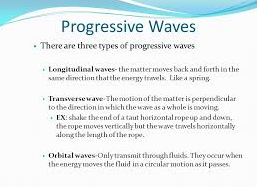Progressive Waves: Definition, Types & Examples
What are Progressive Waves?
The waves which transfer energy by moving away from the source of disturbance are called progressive or traveling waves.
Progressive wave Example
 Consider two persons holding the opposite ends of the rope. Suddenly one person gives a jerk to the rope. The disturbance in the rope produces a pulse that moves towards another person. When this reaches the other person it pushes his hand upward. So the energy and momentum are transferred from one person towards the other person. This is an example of a progressive wave.
Consider two persons holding the opposite ends of the rope. Suddenly one person gives a jerk to the rope. The disturbance in the rope produces a pulse that moves towards another person. When this reaches the other person it pushes his hand upward. So the energy and momentum are transferred from one person towards the other person. This is an example of a progressive wave.
Types of Progressive Waves
There are two types of progressive waves.
- Transverse waves
- Longitudinal waves
Transverse waves
The waves, in which particles of the medium are displaced perpendicular to the direction of propagation of waves are called transverse waves.
How transverse waves are produced?
Take a loose spring coil ( slinky spring) for illustration of motion of source in generating waves in a medium. Slinky is the soft spring that has a small initial length but a relatively large extended figure.
Consider a horizontal spring system with its one end fixed. When the free end is moved from side to side, a pulse of a wave having a displacement pattern, which will move along the spring. This shows that the displacement of particles is perpendicular to the direction of propagation of a wave, hence transverse waves are produced.
Longitudinal waves (Compressional waves)
The waves, in which particles of the medium are displaced along the direction of propagation of waves are called longitudinal waves.
How longitudinal waves are produced?
If one end of the spring is moved back and forth, along the direction of the spring. Then the waves are produced in which displacement of the spring is along to the direction of propagation of wave and such waves are called longitudinal waves.
Why sound waves in the air are longitudinal in nature?
Both types of waves can be set up in solids, however, transverse waves die out very quickly and usually cannot be produced at all. That is why sound waves in the air are longitudinal in nature.
Also read: Transverse Waves Vs Longitudinal waves
